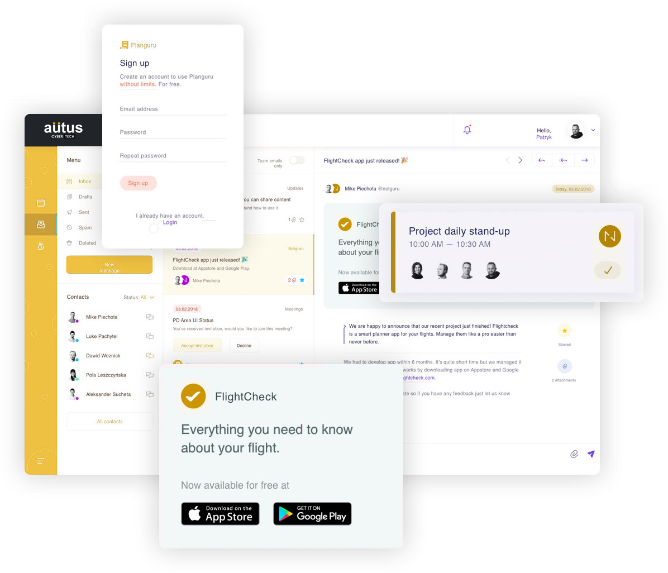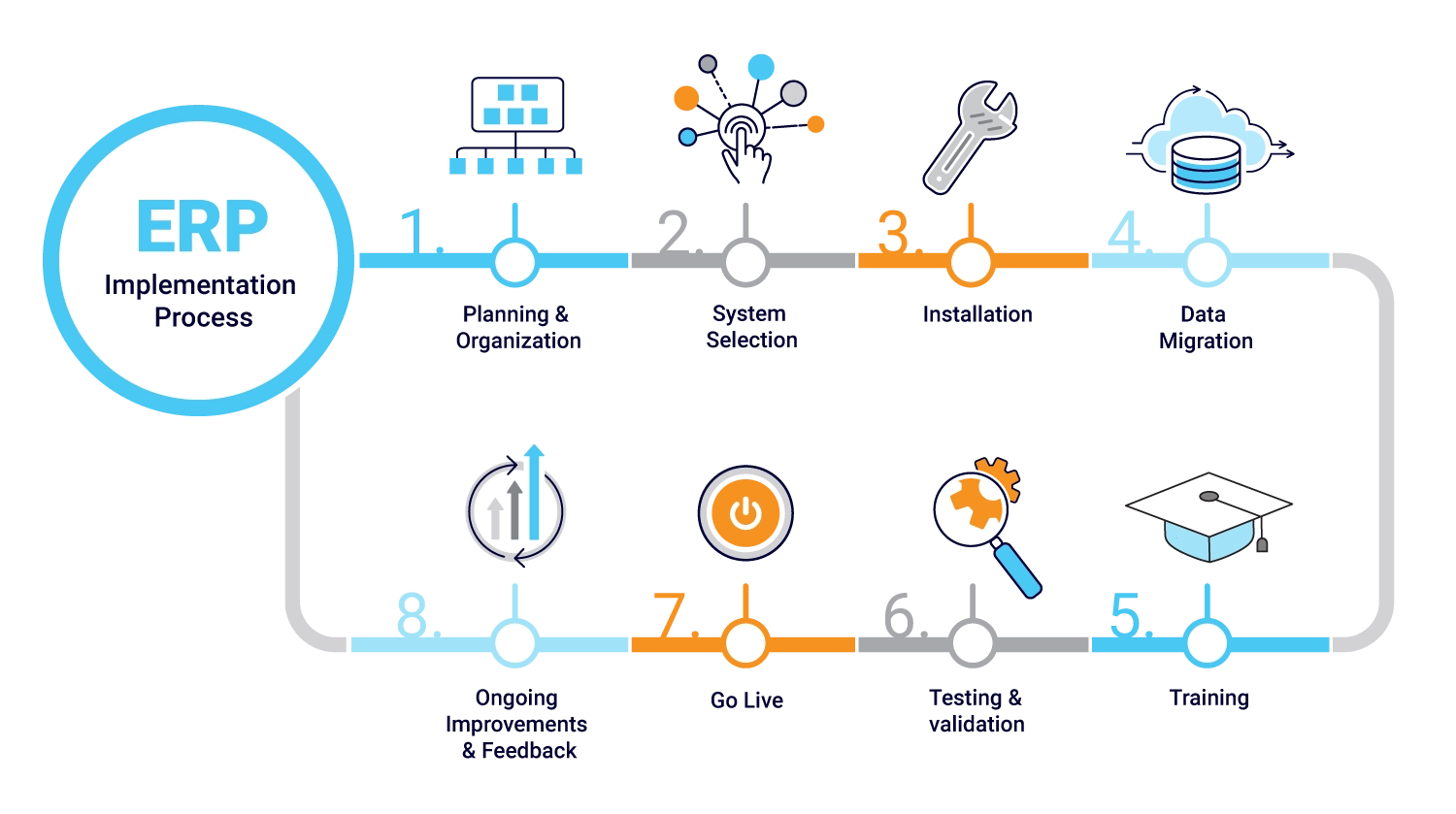Transforming Businesses with Expert Enterprise Resource Planning Implementation

Are you experiencing reduced productivity and tired of having to deal with multiple systems? Running a business without ERP can often feel like this – you work too hard but don’t get the results you desire.
It is no surprise that 95% of businesses have experienced increased work efficiency after a successful ERP implementation.
Opposed to what most organizations believe, Enterprise Resource Planning helps your business with better systems, aids in the strategic decision-making process, and offers enhanced productivity. It is a total game-changer for your business.
For best results , the idea is to clearly define your objectives and divide the entire process into phases. This will help you approach the process systematically and also make it easier for you to monitor the progress. In this detailed guide, we’ll break down the entire procedure for you to understand all the amazing benefits of ERP Implementation for your organization and also implement the best practices. Let’s get started!
The ERP implementation life cycle is a strategically planned procedure for setting up an ERP system for a business. The organization might opt for a cloud-based, on-premise, or hybrid ERP model, but the phases of the remain more or less the same. In simple terms, Enterprise Resource Planning Implementation involves Planning, Configuring, and Deploying ERP in a seamless procedure so that it has the least downtime for business operations and management.
Since ERP is a unified software that replaces all the multiple tools being used by the business, Enterprise Resource Planning System Implementation is all about integrating different business processes like finances, human resources, manufacturing, customer support, and others into a single system. ERP System Implementation is a complex and time-consuming procedure and can take anywhere between a few weeks to a few months based on the size and requirements of the business. The process sounds depleting but is highly rewarding for the overall efficiency and growth of the business.
After the success of the Implementation Process, the organization immediately begins to enjoy the benefits of real-time data availability, faster and efficient reporting, ease of team collaborations, and access to valuable business insights.

In general, the ERP implementation process is divided into six phases and ERP implementation step has a defined objective. Based on your business and its custom needs, these phases may be redefined or might even overlap in some cases.
1. Discovery & Planning
Discovery and planning, which is the first phase in ERP implementation, we begin with research to select our ERP system and also formalize the core project team. The senior management allocates sufficient resources for the project to ensure its smooth execution. The most important task in this step is to get clarity and define the system requirements in detail.
2. Design
In this phase, based on the understanding of the current workflows and processes, a detailed design for the new ERP Implementation is created. The existing users of the current business processes are asked for their inputs. They also help identify gaps in the systems that need to be addressed in the new implementation.
3. Development
Based on the inputs of the design phase, the Enterprise Resource Planning System Implementation enters the development phase. In this step, customizations if any are undertaken and system upgrades are made for the ERP tool to work in harmony with any business tools that are not being replaced by this ERP implementation. The ERP team prepares training material for users and also plans for data migration.
4. Testing
In most cases, the testing phase overlaps with the development phase. The modules that are already developed are tested rigorously for their functionality and efficiency while the team continues to develop the other ERP modules. User acceptance testing and introductory end-user training also commence in this phase.
5. Deployment
This is the phase when the ERP Implementation goes live and made available for users to access. The ERP team gets the first insights from users and is able to address any potential issues before starting with data migration. If need be, the old business systems are concurrently used till the business is ready to completely shift to the new ERP tools.
6. Support & Updates
This is the last phase in ERP implementation life cycle, but also the most crucial phase that defines the success of Enterprise Resource Planning Implementation. The ERP team is readily available to offer training support to business users and address their concerns. They make system adjustments based on feedback and also offer timely support for updates and regular maintenance.
The overall success of ERP implementation process is majorly dependent upon the following best practices:
1. Prioritize Planning
Not planning before execution is the recipe for disaster. Proper planning might delay the process by a few days but it ensures the ERP implementation is in- line with the business goals and proper resources are allocated for ERP development.
2. Focus on Support and Training
The ERP implementation process doesn’t conclude at the development phase. Ongoing support and proper staff training is the key to success.
3. Plan for Migration
It is crucial to note that not all historical data from the old systems needs to find a place in the new ERP. It is best to identify obsolete and redundant data to perform a clean-up before migration.
4. Communicate Clearly
Having the communication channel open throughout the phases of Enterprise Resource Planning System Implementation is a game-changer. Keeping everyone informed ensures the ERP team and business users are working as a team for the success of the project.
5. Executive Sponsorship
Having support from top-level management and executive sponsorship ensures the project has access to the desired resources and that it gets the much-needed support from everyone in the company.
6. Regular Assessments
During the design and development phases, it is best to reassess the project to see if progress is being made as per the estimated timelines. Delays or changes to the schedule, if any must be addressed timely.
A successful ERP integration is the key to business growth and expansion. The process might seem daunting but when you work with an experienced ERP vendor, you can overcome challenges effortlessly and reap the benefits of ERP for your organization.
Proximo ERP is a top-rated and highly trusted cloud based ERP solution. With an array of successful deployments for clients across the globe, we take pride in calling ourselves the best in the industry.
Explore how Proximo from Autus Cyber Tech, an expert ERP software development company, can help you transform your business operations and set the stage for you to experience exponential growth, schedule a free demo and consultation call today!
We are currently running a 100% refund offer for failed implementations! This is a limited period deal that you don’t want to miss out on. Ready to drive your company to its full potential with Proximo ERP? Get in touch with us now!
Contact us today to explore our tailored ERP implementation solutions!
Broadly speaking, the first phase can often be the most challenging because it can sometimes be a task to bring all the teams and top management together to finalize the requirements and get started with the process of ERP implementation.
The first step to avoiding delays is to create a realistic timeline and not be over-ambitious. Since the ERP implementation has many moving parts and each phase is dependent on the other, it is a good idea to reassess the timelines at key points and make changes wherever necessary.
Although the phases of ERP implementation are the same for cloud-based and on-premise ERP, the activities in each phase might vary. The biggest difference is in the hardware requirements and deployment itself.
ERP implementation is a lengthy process that requires extensive resources and can hinder with the other priorities of the business. Through the participation of top executives, the implementation process can be conducted with ease. This can also help avoid delays.
ERP implementation life cycle refers to the phases of ERP setup. There are six phases of ERP implementation starting from planning, design, and development to testing, deployment, and support.
The foremost step for an ERP implementation is discovery and planning. The ERP team gathers requirements from the organization and creates an execution plan based on their goals.